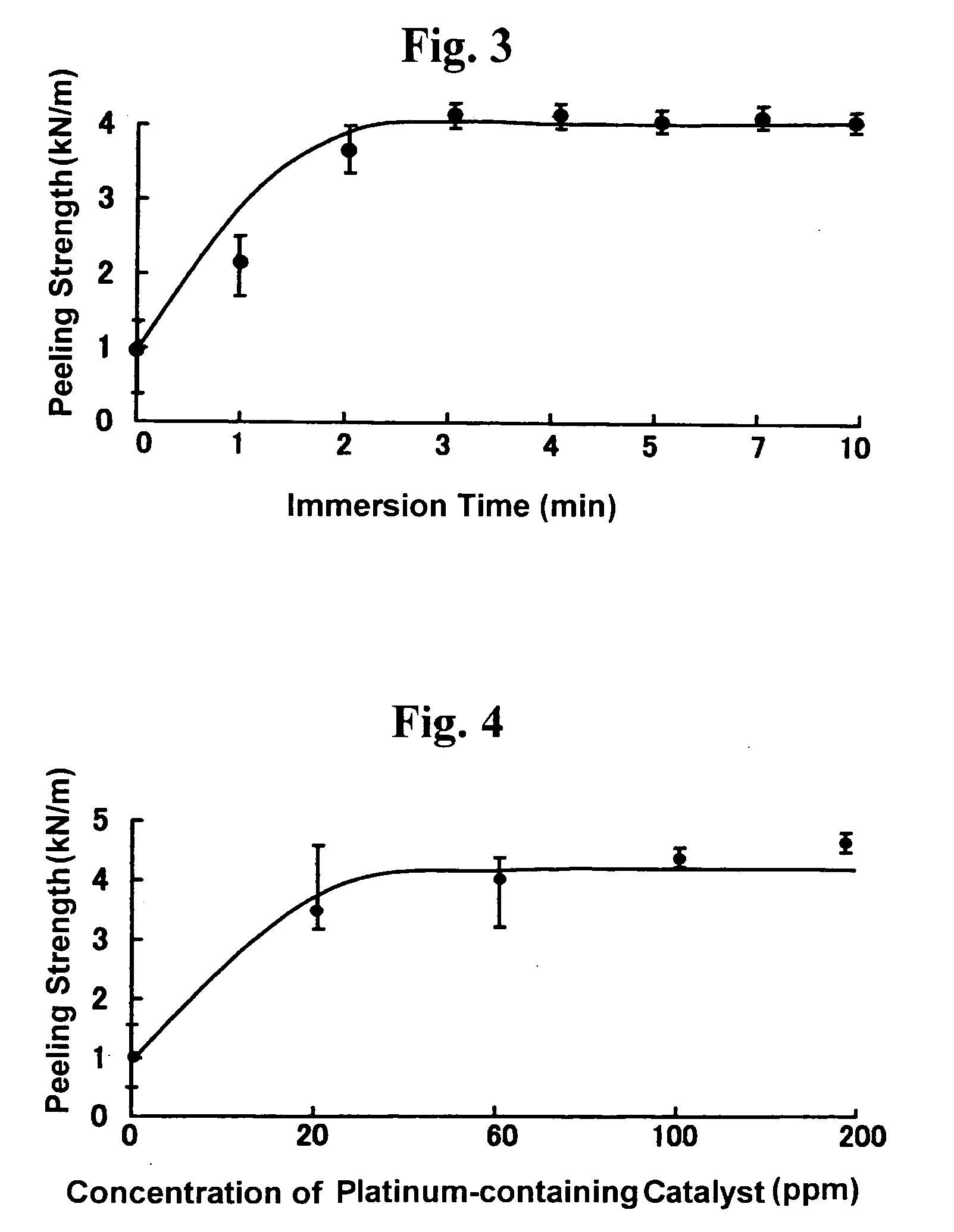Base material for adhesion and silicone rubber-adhered article using thereof
- Summary
- Abstract
- Description
- Claims
- Application Information
AI Technical Summary
Benefits of technology
Problems solved by technology
Method used
Image
Examples
example 1
Reaction of Dimethylsiloxane Having Hydrogen at the Terminal
[0361]HSi(CH3)2OSi(CH3)2H, whose boiling point is at 70 degrees centigrade, and unsaturated silane: CH2═CHCH2Si(OC2H5)3, whose boiling point is at 176 degrees centigrade:
[0362]0.5 mol (67 g) of HSi(CH3)2OSi(CH3)2H, 0.1 mol (20.4 g) of CH2═CHCH2Si(OC2H5)3 and 0.2 ml of a solution including platinum-containing catalyst that catalyses at room temperature of catalog number SIP6830.3 that is available from Gelest Inc. were added in 200 ml conical flask, and the mixture was stirred for 24 hours at 50 degrees centigrade under nitrogen gas stream. After the reaction, the reaction the mixture was distilled to remove unreacted HSi(CH3)2OSi(CH3)2H. Then, 33.8 g of crude HSi(CH3)2OSi(CH3)2CH2CH2CH2Si(OC2Hs)3 was obtained. After the dilution thereof at 82 to 83 degrees centigrade under 10 mmHg of reduced pressure, the desired pure product was obtained.
[0363]Elemental Analysis Found (Calculated): C, 46.0% (46.10%), H, 8.9% (8.93%).
example 2
Method (A) for Manufacturing an Adhesive Base Material Having a Hydrosilyl-Containing Silyl Group on the Surface Thereof
[0364]After treating the surface of substrates such as a polyethylene terephthalate (PET) resin plate of 30 mm by 50 mm, an aluminum plate of 30 mm by 50 mm and a glass plate of 30 mm by 50 mm by corona discharge treatment by Corona Master, the substrates were immersed for two minutes in 0.5 weight % of HSi(CH3)2OSi(CH3)2CH2CH2CH2Si(OC2H5)3 in methanol-water mixed solution whose ratio is 95 / 5 by weight. After drying the substrates at room temperature and heating thereof for 10 minutes at 150 degrees centigrade, an adhesive base material having a hydrosilyl-containing silyl group on the surface thereof was obtained.
[0365]By X-ray-induced photoelectron spectroscopy (XPS) using an equipment of catalog number ESCA-5600 that is available from Physical Electronics Inc., the obtained adhesive base material having a hydrosilyl-containing silyl group on the surface thereof ...
example 3
Method (B) for Manufacturing an Adhesive Base Material Having a Hydrosilyl-Containing Silyl Group on the Surface Thereof
[0366]After treating the surface of a substrate such as a PET resin plate of 30 mm by 50 mm, an aluminum plate of 30 mm by 50 mm and a glass plate of 30 mm by 50 mm by corona discharge treatment by Corona Master, the substrate was immersed for 2 minutes in 0.2 weight % of CH2═CHCH2CH2CH2CH2CH2CH2Si(OCH3)3 in methanol solution. After dying the substrate at room temperature and heating thereof for 10 minutes at 150 degrees centigrade, an adhesive base material having CH2═CH on the surface thereof was obtained. The obtained adhesive base material having CH2═CH on the surface thereof was immersed in 100 ml of isopropanol solution of 10 g of HSi(CH3)2OSi(CH3)2H and 0.2 ml of solution including platinum-containing catalyst of catalog number SIP6830.3 that is available from Gelest Inc. for 10 minutes at 70 degrees centigrade, and an adhesive base material having hydrosily...
PUM
| Property | Measurement | Unit |
|---|---|---|
| Temperature | aaaaa | aaaaa |
| Adhesion strength | aaaaa | aaaaa |
Abstract
Description
Claims
Application Information
 Login to View More
Login to View More - R&D
- Intellectual Property
- Life Sciences
- Materials
- Tech Scout
- Unparalleled Data Quality
- Higher Quality Content
- 60% Fewer Hallucinations
Browse by: Latest US Patents, China's latest patents, Technical Efficacy Thesaurus, Application Domain, Technology Topic, Popular Technical Reports.
© 2025 PatSnap. All rights reserved.Legal|Privacy policy|Modern Slavery Act Transparency Statement|Sitemap|About US| Contact US: help@patsnap.com


